When you arrive at Lee’s Ferry along the Colorado River in Northern Arizona you have two choices, you can float downstream with a permit or go upstream toward Glenn Canyon Dam. The dam is what holds in Lake Powell. This area is popular with trout fishermen (and women) and their motor boats.
Another way to enjoy it is with a watercraft that requires a paddle to move forward like canoes, paddle boards and kayaks. One CAN paddle upstream via river eddies but a better option, and one that gets you 15 miles to the dam in short order, is to take a back-haul upstream. River companies run a daily trip from the dam to Lee’s Ferry. Going upstream the boats are empty so they make a buck charging customers to haul their boats back up river to begin a two-day float down to the Ferry.
We begin our trip, however, at Cliff Dwellers Lodge on Highway 89 a few miles past the turn-off for the Ferry.
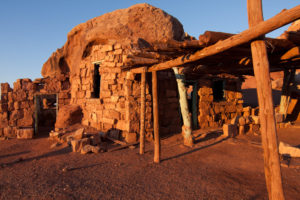 Just before you reach the modern accommodations you can see remnants of very unusual buildings that were built under the overhangs of fallen rocks by Blanche Russell in the 1930s. She ran a restaurant and gas station here.
Just before you reach the modern accommodations you can see remnants of very unusual buildings that were built under the overhangs of fallen rocks by Blanche Russell in the 1930s. She ran a restaurant and gas station here.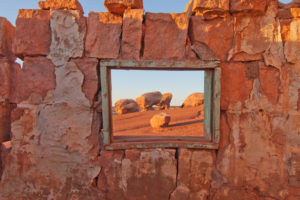
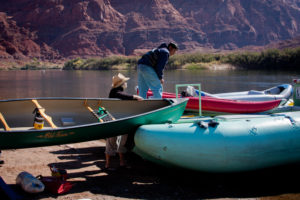 The following morning we met at the Ferry and loaded our boats onto two river rafts.
The following morning we met at the Ferry and loaded our boats onto two river rafts.
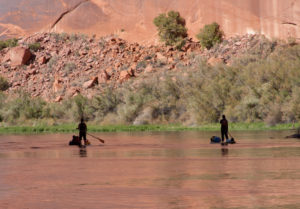 We encountered these two paddle boarders loaded with camping gear. I think this was before the SUP craze hit.
We encountered these two paddle boarders loaded with camping gear. I think this was before the SUP craze hit.
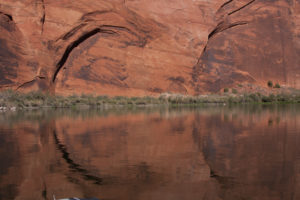 We did this trip the end of October in 2011. The days were warm but the nights got quite cold. The water here is 46 degrees as it comes out from the bottom of Lake Powell when released by the dam. The ride up to the dam was chilly but the scenery was magnificent.
We did this trip the end of October in 2011. The days were warm but the nights got quite cold. The water here is 46 degrees as it comes out from the bottom of Lake Powell when released by the dam. The ride up to the dam was chilly but the scenery was magnificent.
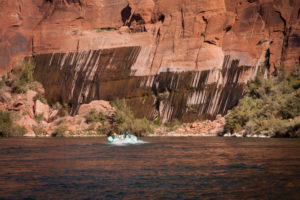 You can tell we are approaching the dam area by the seepage coming out of the sandstone. This type of rock is porous and with the pressure of the water behind the dam there are seepage spots all around it.
You can tell we are approaching the dam area by the seepage coming out of the sandstone. This type of rock is porous and with the pressure of the water behind the dam there are seepage spots all around it.
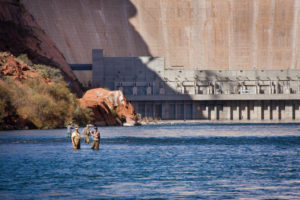 There she is, Glenn Canyon Dam. Regardless of your thoughts on dams in the American West, she is still quite a structure to behold. This is also a popular trout fishing location.
There she is, Glenn Canyon Dam. Regardless of your thoughts on dams in the American West, she is still quite a structure to behold. This is also a popular trout fishing location.
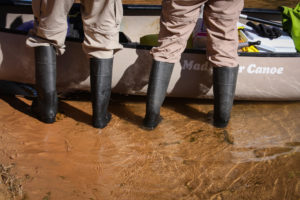 Rubber boots are a must as standing in 46-degree water is no fun. After off-loading our boats and filling them with gear we shove off to see what we can find.
Rubber boots are a must as standing in 46-degree water is no fun. After off-loading our boats and filling them with gear we shove off to see what we can find.
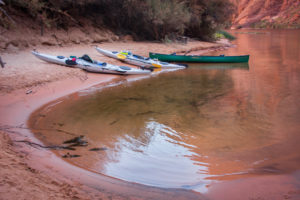 A few of us stopped at this spot to check out some local art.
A few of us stopped at this spot to check out some local art.
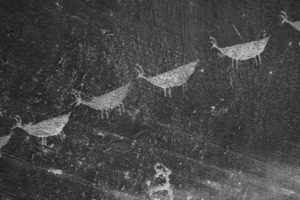 A short hike up a trail brought us to a wonderful petroglyph panel. What’s sad is to think about how many of these sights are buried upstream under Lake Powell.
A short hike up a trail brought us to a wonderful petroglyph panel. What’s sad is to think about how many of these sights are buried upstream under Lake Powell.
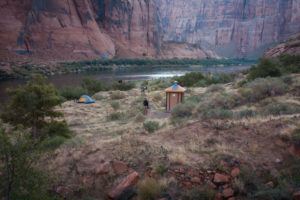 We camped one night here, complete with a porta- potty. Nights were cold and the winter gear definitely came out.
We camped one night here, complete with a porta- potty. Nights were cold and the winter gear definitely came out.
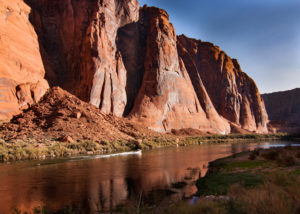 The next morning an eager trout fisherman heads upstream in his power boat.
The next morning an eager trout fisherman heads upstream in his power boat.
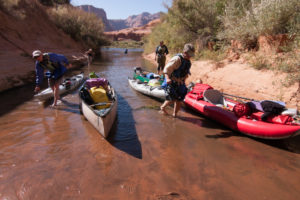 The next day we floated down to Water Holes Canyon.
The next day we floated down to Water Holes Canyon.
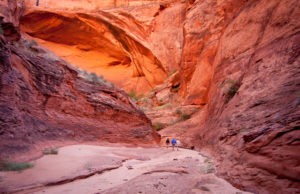 We hiked back as far as we could until the terrain got a little sketchy with boulders and cliffs.
We hiked back as far as we could until the terrain got a little sketchy with boulders and cliffs.
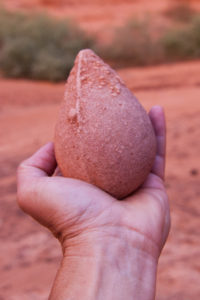 I found this rock…
I found this rock…
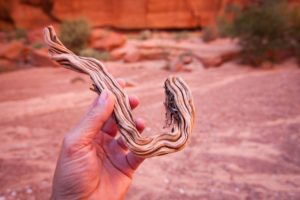 and this stick.
and this stick.
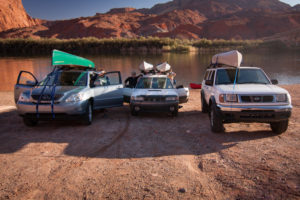 Here we are at the take-out at Lee’s Ferry. It was a quick Friday night, Saturday to Sunday float but well worth it. It’s definitely one we need to do again.
Here we are at the take-out at Lee’s Ferry. It was a quick Friday night, Saturday to Sunday float but well worth it. It’s definitely one we need to do again.
Happy shooting!
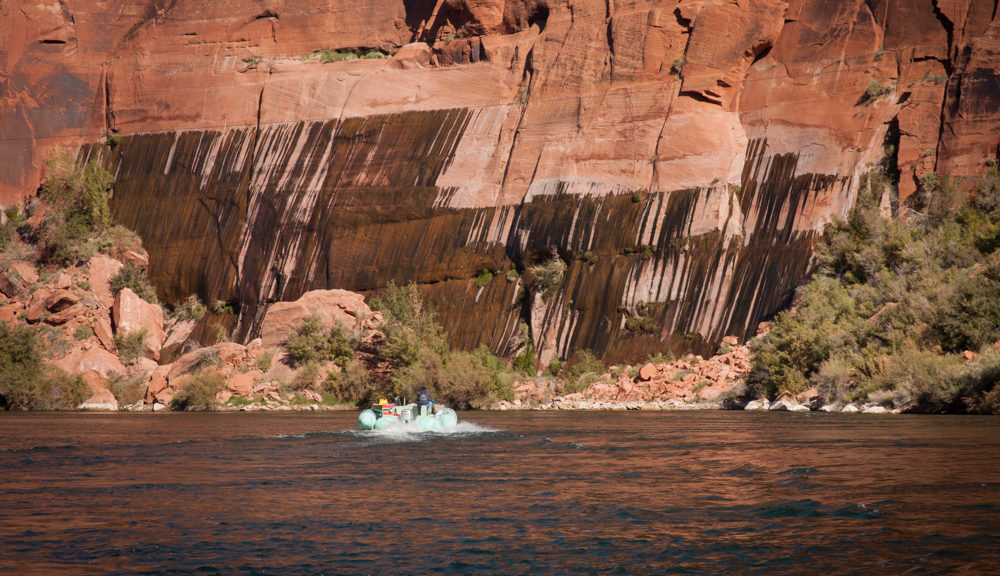
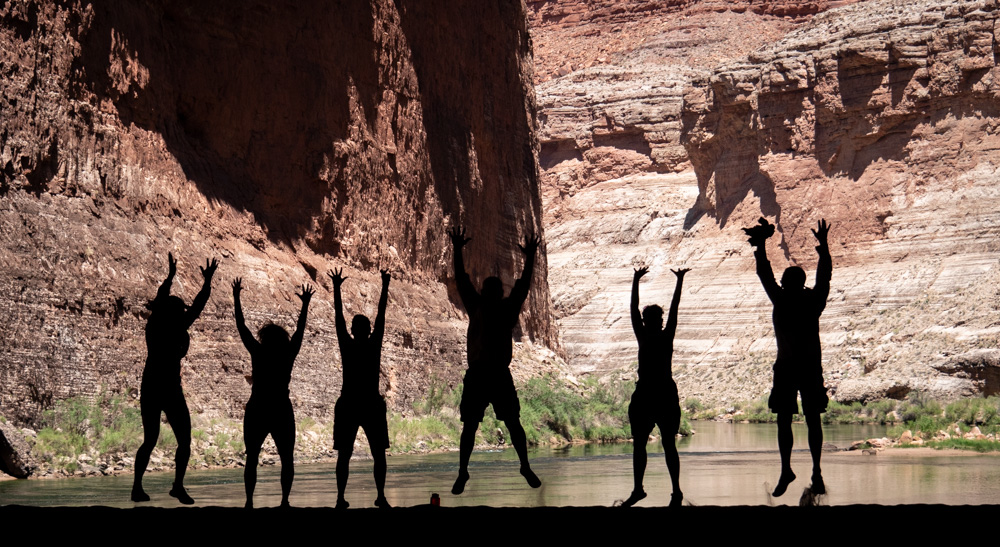
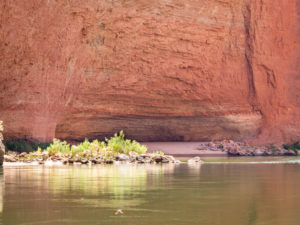
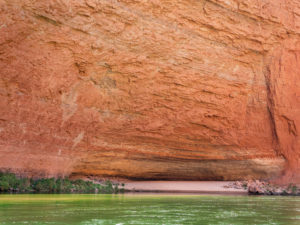
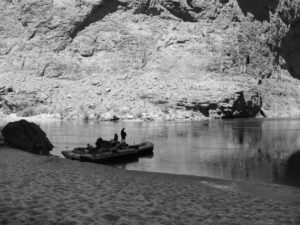
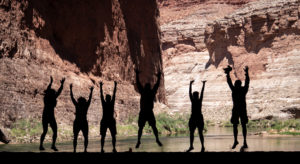 To get a good silhouette you just need the background to be lighter than your subject. And don’t expose for your subject, expose for the lit up background.
To get a good silhouette you just need the background to be lighter than your subject. And don’t expose for your subject, expose for the lit up background.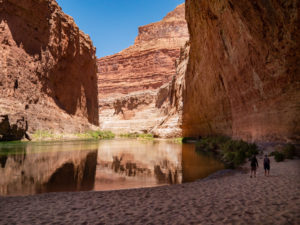 This is shooting upriver with two people in it to try to show scale.
This is shooting upriver with two people in it to try to show scale.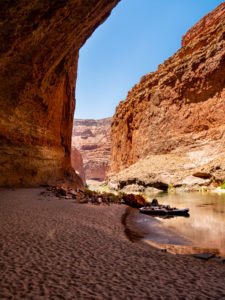 This is shooting from one end of the opening to the other where our 36-foot raft was parked. The boat looks small and the people tiny. This begins to give you some idea of the immensity of the cavern.
This is shooting from one end of the opening to the other where our 36-foot raft was parked. The boat looks small and the people tiny. This begins to give you some idea of the immensity of the cavern.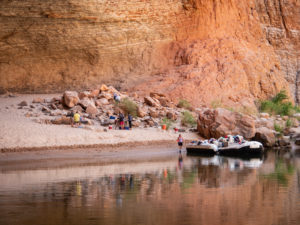
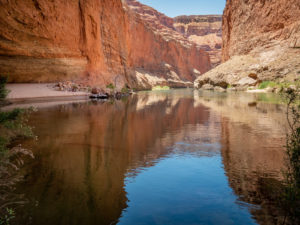
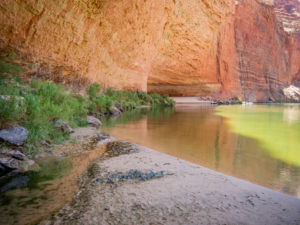

 It’s also calm enough to play with reflections.
It’s also calm enough to play with reflections. There are plenty of places to park and explore. Folks like to fish here but you are NOT allowed to swim. That’s a big bummer in my family.
There are plenty of places to park and explore. Folks like to fish here but you are NOT allowed to swim. That’s a big bummer in my family. There is abundant wildlife. The fun thing about paddling and shooting is the ability to be closer to it.
There is abundant wildlife. The fun thing about paddling and shooting is the ability to be closer to it. Plenty of Blue Heron which are SO beautiful.
Plenty of Blue Heron which are SO beautiful. Random geese hanging out watching the boaters. Speaking of which I’ve never seen a motorboat on this lake. I don’t think they are allowed. That lack of engine noise is really nice.
Random geese hanging out watching the boaters. Speaking of which I’ve never seen a motorboat on this lake. I don’t think they are allowed. That lack of engine noise is really nice.


 …grass designs
…grass designs …or designs in dried out wood.
…or designs in dried out wood.

 The evening light in January was also beautiful. This might be a great place to catch incoming monsoons in August!
The evening light in January was also beautiful. This might be a great place to catch incoming monsoons in August! More silhouettes with sunset colors as a backdrop.
More silhouettes with sunset colors as a backdrop. The Canadians were active on that weekend in January.
The Canadians were active on that weekend in January. There are also plenty of geese and ducks which the park sends a guy around to feed a couple of times a week. I could have spent the morning shooting just them!
There are also plenty of geese and ducks which the park sends a guy around to feed a couple of times a week. I could have spent the morning shooting just them!


















 My niece, Katie, recently purchased her own inflatable paddle board so we were all excited to take her out for on its maiden voyage. Normally, in a kayak or canoe, I bring my Lumix GX-8, 14-150 lens and store it in an ammo can. I wasn’t sure what to do on the paddle board so I settled on my Canon S120 point and shoot and my little Pelican case secured to the handle at the center of my boat. There I had easy access when I needed it.
My niece, Katie, recently purchased her own inflatable paddle board so we were all excited to take her out for on its maiden voyage. Normally, in a kayak or canoe, I bring my Lumix GX-8, 14-150 lens and store it in an ammo can. I wasn’t sure what to do on the paddle board so I settled on my Canon S120 point and shoot and my little Pelican case secured to the handle at the center of my boat. There I had easy access when I needed it. There is a lot of easy car access to the waters of Lake Pleasant. The cool thing about that is it provides for some hands on RV shopping. We liked this rig a lot so I shot it. They had outdoor cooking as an option and even a solar cooker!
There is a lot of easy car access to the waters of Lake Pleasant. The cool thing about that is it provides for some hands on RV shopping. We liked this rig a lot so I shot it. They had outdoor cooking as an option and even a solar cooker! We hadn’t paddled this part of the lake before but had a rough idea of where to go based on an REI paddle board class we had taken at Lake Pleasant, but a slightly different location, in early June. So we blew up the inflatable boards and off we went. As we passed a pair of kayakers I asked what they knew about the area. They directed us to a “secret canyon” behind a rock in an alcove. We headed straight for it.
We hadn’t paddled this part of the lake before but had a rough idea of where to go based on an REI paddle board class we had taken at Lake Pleasant, but a slightly different location, in early June. So we blew up the inflatable boards and off we went. As we passed a pair of kayakers I asked what they knew about the area. They directed us to a “secret canyon” behind a rock in an alcove. We headed straight for it.  On the way we found a heard of wild donkeys! SO cool. They were just hanging out eating grass. I’d been seeing signs posted about them for a while now but never saw a donkey. Check THAT off the bucket list!
On the way we found a heard of wild donkeys! SO cool. They were just hanging out eating grass. I’d been seeing signs posted about them for a while now but never saw a donkey. Check THAT off the bucket list! This is toward the opening of the secret canyon. The water in the lake was crazy low but it still went back pretty far. We dropped to our knees though as we didn’t know how shallow the water was and it was pretty murky. We ended up paddling around and between a lot of dead trees.
This is toward the opening of the secret canyon. The water in the lake was crazy low but it still went back pretty far. We dropped to our knees though as we didn’t know how shallow the water was and it was pretty murky. We ended up paddling around and between a lot of dead trees. The canyon got smaller and smaller and more and more stagnant.
The canyon got smaller and smaller and more and more stagnant. Around the final bend we came upon a Great Blue Heron hanging out on the shore.
Around the final bend we came upon a Great Blue Heron hanging out on the shore. This is pretty much the end of the lake in the arm we were in. It brought us to this orchard of dead trees with two egrets at the end of it. The second one had just taken off.
This is pretty much the end of the lake in the arm we were in. It brought us to this orchard of dead trees with two egrets at the end of it. The second one had just taken off. We hit every cove on the way back. Again, negotiating around the trees was a challenge. They gave it a bit of an eery feeling.
We hit every cove on the way back. Again, negotiating around the trees was a challenge. They gave it a bit of an eery feeling. I climbed to the top of a hill and got this bird’s eye view of the cove we paddled into. You can see how low the lake is. At the beginning of summer it was at the top of the green stripe on the far side.
I climbed to the top of a hill and got this bird’s eye view of the cove we paddled into. You can see how low the lake is. At the beginning of summer it was at the top of the green stripe on the far side.

 It is definitely not my beloved Lake Powell but in a pinch, it served us well. Lots of wildlife, warm temperatures and good company.
It is definitely not my beloved Lake Powell but in a pinch, it served us well. Lots of wildlife, warm temperatures and good company. Somebody lost a red paddle.
Somebody lost a red paddle. More wildlife.
More wildlife.

 This images shows a crew of surfers making their way to the water taxis lined up along the river bank. You can see one heading out in the right side of the image.
This images shows a crew of surfers making their way to the water taxis lined up along the river bank. You can see one heading out in the right side of the image. Some boats had one motor, some two. All were open air and most had a canopy overhead. Ours also had a plastic sheet that fell could be lowered down the sides as shown in the image above. That proved handy the morning we left as the splash worked perfectly with the wind and would have soaked us had our boatmen not lowered the protective sheeting.
Some boats had one motor, some two. All were open air and most had a canopy overhead. Ours also had a plastic sheet that fell could be lowered down the sides as shown in the image above. That proved handy the morning we left as the splash worked perfectly with the wind and would have soaked us had our boatmen not lowered the protective sheeting. There were also plenty of locals paddling in and out of the port in their cayucos, canoes dug out of the local Cayuco tree. Some of these boats actually had sails that could be hoisted to assist in crossing the ocean between islands.
There were also plenty of locals paddling in and out of the port in their cayucos, canoes dug out of the local Cayuco tree. Some of these boats actually had sails that could be hoisted to assist in crossing the ocean between islands. It looks like this father and son team is heading in to fill water jugs.
It looks like this father and son team is heading in to fill water jugs. Here is a water taxi approaching the mouth of the river. It is coming in from the islands.
Here is a water taxi approaching the mouth of the river. It is coming in from the islands. We stopped at a neighboring island on our way to Naranjo Chico to pick up some plantains. This boat taxi was moored out away from the dock. It reminds me of a cowboy tying up his horse.
We stopped at a neighboring island on our way to Naranjo Chico to pick up some plantains. This boat taxi was moored out away from the dock. It reminds me of a cowboy tying up his horse. While waiting for the plantains I noticed some wee ones playing “out in the yard”? It looks like a one “car” family (the cayuco on the dock).
While waiting for the plantains I noticed some wee ones playing “out in the yard”? It looks like a one “car” family (the cayuco on the dock). We arrived and got off the boat. This is an image of our “resort”. The hut to the left is for guests, the red roofed one is the dining room/kitchen, the two to the right are guest huts. Ours is the left one on the right.
We arrived and got off the boat. This is an image of our “resort”. The hut to the left is for guests, the red roofed one is the dining room/kitchen, the two to the right are guest huts. Ours is the left one on the right. We stayed here three nights. It was pretty cool having waves lap under our hut each night. Ellen is standing in the doorway of our front porch. Behind her is another door that leads to our humble abode. It was a single room with two beds AND a separate bathroom. Seriously, indoor plumbing. The walls let the breeze in between the sticks, it was heaven.
We stayed here three nights. It was pretty cool having waves lap under our hut each night. Ellen is standing in the doorway of our front porch. Behind her is another door that leads to our humble abode. It was a single room with two beds AND a separate bathroom. Seriously, indoor plumbing. The walls let the breeze in between the sticks, it was heaven. This is a view looking toward our resort. Look at the color of that water. Wow.
This is a view looking toward our resort. Look at the color of that water. Wow. How iconic is THIS shot? Some of the best snorkeling I’ve ever done was right outside our front door. Hammocks were everywhere. I think they sleep in them. They, meaning the Guna People, live on the islands. There are around 365 islands in all but only 40 are inhabited.
How iconic is THIS shot? Some of the best snorkeling I’ve ever done was right outside our front door. Hammocks were everywhere. I think they sleep in them. They, meaning the Guna People, live on the islands. There are around 365 islands in all but only 40 are inhabited. This is the dock on the other side of the island. It took three minutes to cross the center of the island and get there. This side of the island is all grass and sand so it was great having the rocks and coral just outside of our hut for snorkeling.
This is the dock on the other side of the island. It took three minutes to cross the center of the island and get there. This side of the island is all grass and sand so it was great having the rocks and coral just outside of our hut for snorkeling. This is the view down the beach behind our hut. Those palm trees in the distance are the far end of the island.
This is the view down the beach behind our hut. Those palm trees in the distance are the far end of the island. This is our resort’s dog. Dang, I forgot his name. Ruby? Maybe? He was sweet. We’d run into him all over the island. Here he is leaning up against the opening to the dining room. A couple of times we found him snoozing on our front porch.
This is our resort’s dog. Dang, I forgot his name. Ruby? Maybe? He was sweet. We’d run into him all over the island. Here he is leaning up against the opening to the dining room. A couple of times we found him snoozing on our front porch. Here’s the local school bus. A couple days a week this boat would load up with kids and they’d be ferried to a nearby island to attend school.
Here’s the local school bus. A couple days a week this boat would load up with kids and they’d be ferried to a nearby island to attend school. This was our personal taxi for the three days we were there.
This was our personal taxi for the three days we were there. Our resort was all inclusive. It included three meals a day and an afternoon excursion. Sunday’s excursion was to go to a nearby island and get a tour. It was very interesting. Here is a modern house as we pulled up to the dock. There were also huts.
Our resort was all inclusive. It included three meals a day and an afternoon excursion. Sunday’s excursion was to go to a nearby island and get a tour. It was very interesting. Here is a modern house as we pulled up to the dock. There were also huts. Here’s another view, in a different direction, of less modern accommodations.
Here’s another view, in a different direction, of less modern accommodations. We were laughing as I was shooting at how my images would portray a ghost island as we were asked not to photograph any of the locals unless we compensate each of them. There were SO many, everywhere, that I chose to shoot in other directions. I think this is main street and it looks deserted.
We were laughing as I was shooting at how my images would portray a ghost island as we were asked not to photograph any of the locals unless we compensate each of them. There were SO many, everywhere, that I chose to shoot in other directions. I think this is main street and it looks deserted. Coconuts are an important commodity on the islands. On our own island we were asked not to pick any up and eat them but to purchase them from a native.
Coconuts are an important commodity on the islands. On our own island we were asked not to pick any up and eat them but to purchase them from a native. Clothes were hanging everywhere, all the time. I wondered if they just stored them on the line due to humidity instead of in a drawer where they would…mold?
Clothes were hanging everywhere, all the time. I wondered if they just stored them on the line due to humidity instead of in a drawer where they would…mold? This is one of the classrooms.
This is one of the classrooms. Our friend Claudia bought a bracelet from this lady. The other rule is, if you purchase something, you can photograph the artist.
Our friend Claudia bought a bracelet from this lady. The other rule is, if you purchase something, you can photograph the artist. We bought a mola from this beautiful lady, the mother of our island guide. Once I asked if I could take her picture she grabbed her grandbaby and wanted images of the two of them. It was really sweet.
We bought a mola from this beautiful lady, the mother of our island guide. Once I asked if I could take her picture she grabbed her grandbaby and wanted images of the two of them. It was really sweet. Walking down the dock to leave I grabbed this shot of their transportation collection. I love boats.
Walking down the dock to leave I grabbed this shot of their transportation collection. I love boats.



















